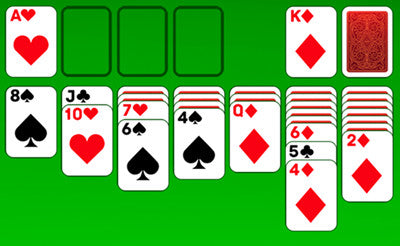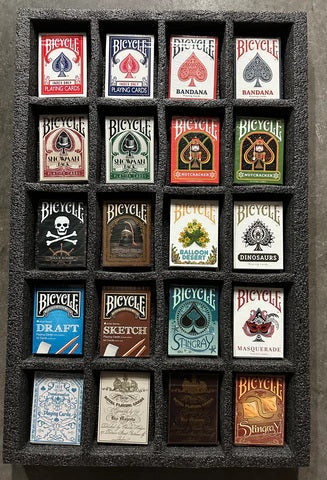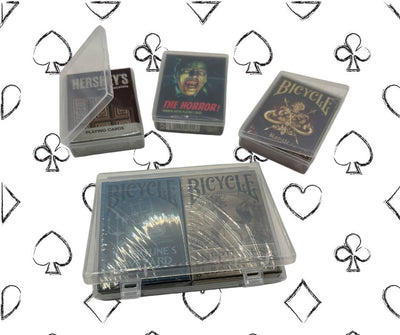(Pictured above: The set up of a traditional game of Klondike Solitaire)
Card Game Rules for Solitaire
Solitaire or Patience, as it is commonly called in parts of Europe, is a game that can be played with just one player, and requires only a standard deck of 52 playing cards. The objective of most solitaire games is to organize a shuffled deck of cards into four piles (one for each suit) in ascending order from Ace to King.
The most well-known version of Solitaire is Klondike, which is what is explained here, and is the game that most people identify with “solitaire”. Many other versions of Solitaire also exist, some of which will be covered following this explanation of how to play Klondike Solitaire.
For more classic card games, check out our guides for 40 Great Card Games for All Occasions, and for The Best Two Player Card Games, as well as our index for Card Game Rules..
If you are looking for cards to play Solitaire with, pick up one of our standard decks of Bicycle Playing Cards with red backs or blue backs, or check out one of our more recent arrivals.
A version of Solitaire that you can play online for free can be found here.
The Set Up
In Solitaire, there are four types of piles: the tableau, the stock, the waste, and the foundations.
The Tableau and the Stock
The tableau consists of seven piles. The first pile has one card, the second pile has two cards, the third pile has three cards, and so on until there are seven piles. Only the top card in each pile is face up.
The cards remaining after building the tableau are placed face down and are called the stock.
The Waste and the Foundation
The waste is where three cards will be dealt face up from the stock as the game proceeds, with only the top card visible.
The foundations consist of four stacks of cards (one for each suit) in ascending order (Ace to King). At the beginning of the game, the foundations are empty. The goal is to play all the cards to these four foundations.
How to Play
The object of Solitaire is to move all cards to the foundations in ascending order, beginning with the Ace and ending with the King.
The first thing to do when starting a new game is to move any available Aces from the tableau to the foundations.
In the example below, the Ace of Diamonds and Ace of Hearts can be moved to the foundations.
Next, you'll want to see if there are any Twos that can be moved to the foundations on top of the Aces already played there. In general, it is a good idea to move low-numbered cards to the foundation whenever possible.
In the example below, the Two of Diamonds can be moved to the foundation, on top of the Ace of Diamonds.
When no more cards can be moved to the foundation, take a look at the tableau. Cards can be moved from one pile in the tableau to another pile, as long as the card being moved is one number lower and the opposite color (red vs black) to the card it is placed on.
In the example below, the 10 of Diamonds (red) can be placed on the Jack of Clubs (black).
Multiple cards can be moved together, as long as the cards in the sequence being moved are in descending order and are in alternating colors (red/black, etc).
In the example below, the Jack of Clubs can be moved onto the Queen of Diamonds, and the 10 of Diamonds is moved together with it.
When there are no more available moves on the tableau, you can draw 3 cards from the stock.
In the example below, the three cards drawn are the 6 of Clubs, Jack of Clubs, and King of Hearts.
Check to see if the top card on the waste can be moved to the tableau or the foundations.
In the example below, the top card is a King of Hearts. This is fortunate because there is an empty pile, and a King is the only card that can be moved to an empty pile. Now the card below it, the Jack of Clubs, becomes available.
Keep moving cards from the tableau to the foundations if you can, or placing them on other piles within the tableau, in order to make more face down cards available. When you can’t make any moves from the tableau, flip up another three cards from the stock to the waste, and continue playing.
You continue this process, flipping three cards from the stock to the waste whenever you get stuck. The goal is to keep playing cards to the tableau and to the foundations.
As shown in the example below, if you successfully manage to move all the cards to the foundations, you have won the game.
Now that you know the rules of solitaire, you are ready to play a game of solitaire online for free. Sites we recommend for doing this include online-solitaire.com, solitaired.com, and solitr.com. For solitaire software we recommend BVS Solitaire, which is available for all platforms.
If you are still in doubt about the rules, take a look at the video tutorial below.
For more information on the game of Solitaire and its rules, check out the Wikipedia article on Klondike Solitaire.
History
Solitaire is a delightful puzzle game that boasts a wonderful history. The game was first recorded in the 1780s in a German book about games, entitled Das Neue Königliche L'Hombre-Spiel. Some early evidence suggests that Solitaire began as a fortune telling game, and only later became a game of strategy. Some variants of Solitaire are still used for cartomancy today.
From the Rhineland, the Solitaire craze moved west into France. From the French we get many of the terms still used in Solitaire today. For example, Tableau is French for “Table”, and Talon is French for “Heel”.
It is popularly rumoured that Napoleon spent most of his days playing Solitaire while he was in exile. In reality, however, it is more likely that he played the common game of Whist, but it does make for a fun item of solitaire-related trivia.
Solitaire became increasingly popular throughout the 19th century, and moved west into England, where Prince Albert was a notable lover of the game. In 1870, the first collection of Solitaire games in the English language appeared, with the book Illustrated Games of Patience by Lady Adelaide Cadogan.
The popularity of Solitaire steadily increased throughout the 20th century. The game became widely played in the computer era, when a free digital version was included in the Microsoft Windows operating system.
Other Popular Solitaire Games
Hundreds of different solitaire games exist other than Klondike Solitaire, and often each of these have multiple variations. Here is a brief overview of some of the more popular ones, as well as an introduction to a few lesser known but interesting versions of the game.
Spider
Spider is a popular solitaire game that is more difficult to win than Klondike Solitaire. In Spider there are two decks of cards in play, with ten tableau piles, no foundations, and no waste pile.
The aim is to create a sequence of 13 cards of the same suit in descending order from King to Ace within a single tableau pile, at which point those 13 cards are removed from the game. The game is won if you successfully discard all the cards in the game in this way.
Building within the tableau piles works somewhat similar to Klondike, but when no moves can be made within the tableau, one card from the stock is dealt to each tableau pile.
FreeCell
Invented in the 1980s and popularized by its digital version, FreeCell is a very winnable solitaire game that involves real strategy.
The setup involves eight tableau piles of face-up cards, the first four with seven cards each and the last four with six cards each. Instead of stock and waste piles, there are four empty storage piles, called “cells”. Any one card may be placed in these reserve piles, and that’s where the strategy comes in.
Unlike Klondike, sequences of cards cannot be moved within the tableau, but only one card can be moved at a time. Tableau piles can only be built downwards in alternating colours. The goal is to remove all the cards to the four foundations by suit, in ascending order from Ace through King.
Beleaguered Castle
Beleaguered Castle is another classic solitaire game, but is more challenging to win.
The goal is to play all the cards to the foundations, which are built up by suit in order from Ace through King. Only the top card in each tableau can be played. Players may also move cards within the tableau as long as the card being moved is one less in value than the card it is being moved to, ignoring suits.
Many variants exist in the Castle family of solitaire games, such as Streets and Alleys. In this variation, the Aces don't begin as starting foundations, but are part of the initial tableau, which consists of rows of seven rather than six cards each.
Yukon
Yukon uses a single deck of playing cards, and all the cards are dealt out from the start of the game, so there is no stock or waste pile.
Set-up happens by making a traditional tableau much like Klondike, but all except the first pile receive an additional five face-up cards each.
Play within the tableau and to the foundations is similar to Klondike, but with the removal of one restriction: a group of face up cards within the tableau may be moved regardless of sequence.
Forty Thieves
Forty Thieves, also called Napoleon at St. Helena, is somewhat similar to Klondike, but uses two decks, and has some different rules for tableau building. At the start of the game there are ten tableau piles, each with four cards (making up the “forty thieves” that the game is named after).
There are eight foundations, and like Klondike Solitaire the game is won when all the cards are transferred to the foundations, which are built from Ace through King by suit.
The tableau is built with cards of the same suit (instead of alternating colours) in descending sequence. Any card may fill a space created by an empty pile.
The Forty Thieves family of solitaire games is one of the largest and most strategic solitaire games. Many variations exist, such as Emperor, which begins with each pile having a face-up card on top of three face-down cards.
The Wish
The Wish is one of the simplest solitaire games, and fits into the “adding and pairing” family.
You remove the 2s through 6s from a standard deck, and with the remaining cards make eight piles of four cards each, with only the top card face up in each pile.
The goal is to remove all the cards, which happens by removing any pair of cards that have the same value. Once cards are paired, you can flip over the face-down card underneath, and continue play. If you successfully remove all the cards, you win the game!
Accordion
Unlike most of the previous solitaire games, Accordion is a non-builder game, so it doesn’t involve building in a tableau or to foundations. To set-up, all 52 cards are placed individually face up in a single continuous line, which is usually done by placing them in rows as space and need requires.
A card can be stacked onto a card to the immediate left or three cards to the left if it is the same suit or if it is the same rank. For example, suppose a row consists of 7H, 8H, 2C, 7D, and 7H. In this case the 7H can be placed either on top of the 8H or on top of the 7D.
By making as many such moves as possible, the objective is to stack up the entire deck.
Bowling Solitaire
Bowling Solitaire is a clever and thematic game created by Sid Sackson. It requires just 20 cards in two suits, and only the Aces through 10s are used. A pyramid of face-up cards with rows of four cards, three rows, two cards, and one card represents the “pins”. Three piles represent the “bowling balls”, consisting of five cards, three cards, and two cards, with only the top card face-up in each.
The bowling ball piles are used knock down pins, which can happen in one of three ways:
- The pin card has the same value as the ball card.
- The combined value of two or more pin cards equals the value of the ball card.
- The last digit of two or more pin cards equals the value of the ball card.
Like regular bowling, the player has two bowls per set of pins before they reshuffle the pin cards and make a new pyramid. If they cannot knock down any pins, it is a gutter ball and they move onto the next ball pile. Scoring is done like regular bowling.
Kings in the Corner
Kings in the Corner is a variation of Solitaire that can be played with two to four players.
Seven cards are dealt to each player, and the remaining cards are placed face down in the middle of the gameplay area to form the stock. The top four cards of the stock are turned face-up on each side of the deck in a cross-shaped design, and serve as four starting foundation piles.
A player’s turn consists of first drawing the top card from the stock, and then making as many moves as possible by laying off cards from their hand onto the four foundation piles, in alternating color and decreasing rank.
New foundation piles can be established by placing a King in the gameplay area. Entire piles can be moved onto another pile if they continue the sequence, after which any new card can be played to replace the previous pile. The first player to play all of the cards from their hand wins the game.
Other Solitaire Games and Resources
We love solitaire games here at PlayingCardDecks, and they are a wonderful way to use your favourite playing cards. To help introduce you to more excellent solitaire games, we have written many articles about the best solitaire games, and to point you to other great resources about solitaire.
Getting started with solitaire
- What You Should Know About Solitaire
- What's Good About Solitaire Card Games
- The Three Most Played Solitaire Games: Klondike, Spider, and FreeCell
- Two More Most Played Solitaire Games: Pyramid, and Golf
Builder solitaire games
- Popular Builder Solitaire Card Games
- More Popular Builder Solitaire Card Games
- 10 Builder Solitaire Card Games With Unusual Layouts
- 10 Less Common but Popular Two-Deck Solitaire Card Games
- Single-Deck Builder Solitaire Games That You Should Try
- Simple Builder Solitaire Card Games
Non-builder solitaire games
- Popular Adding and Pairing Solitaire Card Games
- Popular Non-Builder Solitaire Card Games
- Single-Deck Non-Builder Solitaire Games That You Should Try
- Simple Non-Builder Solitaire Card Games
Solitaire resources
- Advantages of Digital Solitaire
- Best iPad & iPhone Solitaire Apps
- Best Digital Resources For Playing Solitaire
- Special Features for Your Best Experience With Digital Solitaire
Acknowledgement: Thanks to John Taylor for his initial draft, Holger Sindbaek for his insights and images, and EndersGame for his corrections, additions, and further development.
Looking for more card games to play? Check out these two articles:
About the author: John Taylor is a content writer and freelancer through the company Upwork.com. You may view his freelancing profile here. He has a B. A. in English, with a specialty in technical writing, from Texas A&M University and a M. A. in English from the University of Glasgow. You may view his previous articles about card games here and his LinkedIn profile here.






6 comments
i read it, i try to find mistakes.
u wrote there
“When there are no more available moves on the tableau, you can draw 3 cards from the stock.
In the example below, the three cards drawn are the 6 of Clubs, Jack of Clubs, and King of Hearts”
it has to be :
the three cards drawn are the 6 of Spade, Jack of Clubs, and King of Hearts.
Thank you for these many variations and the historic background is great too. I am have played the classic Klondike forever, and tonight it was fun to learn and challenge the Yukon.
Been playing since a child now 60 years old many games I have tried..I see some ne ones here.
My hands are fast …I would try to be fast and have set my own rules when I feel up to the challenge just to make the play last longer and the thinking process a bit smarter. In such a rule I would lay out my game but in my Tableau I work on sticking with only clubs- heart or diamond- spade it can get a bit tricky in the play but it can make your playing time longer special when it only takes three to two minutes to play..
Or I switch by instead of building up the Fountain with Aces Use Kings …I feel its a good brain work out. . Oh and try the pryamid using tow decks or three long gaming time but thrilling.. or a great way for a child to start is matching game… There are so many ways to play a card game but the first way is with a good deck of Bicycle Playing Cards !!! Thank you for so many years of keeping my fee time entertained.
I think its just a typo for recycle, as the y&u are right next to each other in typing.
Thank you, I had forgotten how to play solitaire. Very helpful, awesome teacher!